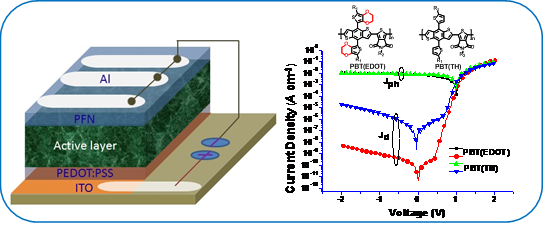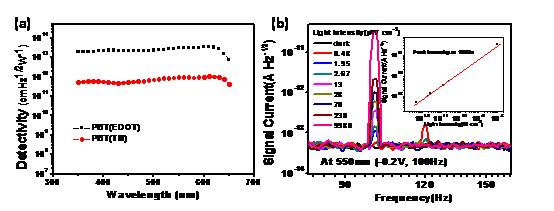Recently, Yongye Liang’s research group developed a newmolecular engineering approach for highly sensitive polymer photodetectors. He and his colleagues describe the new approach in a study (“Toward highlysensitive polymer photodetectors by molecular engineering”) published in the journal “Advanced Materials” (impact factor 17.493).
Owing to their high designability over properties,solution-processibility and flexibility, conjugated polymers have been regarded as a class of promising materials for new generation optoelectronics.Conjugated polymers can be applied as active materials for photodetectors,which are important for environmental monitoring, data communication, imagesensing, and so on. High external quantum efficiency, fast response, selectiveor wide range detection in the ultraviolet to near-infrared region, have been demonstratedin polymer photodetectors. In addition, large area detection and the capability of processing on flexible substrates at room temperature, can pave new ways forsensing and detection technologies.
Similar to polymer solar cells, polymer photodetectors usually adopt a bulk heterojunction (BHJ) structure. This structure facilitates photonabsorption and charge separation for the active materials, affording highexternal quantum efficiency. However, the phase separation of BHJ is difficultto control and it usually suffers a relatively high dark current density at negative bias and low rectification ratio between forward/reverse bias due to unfavorable charge transport and injection. In order to reduce the darkcurrent, commonly adopted approaches including increasing the thickness of theactive layer, or interfacial modification. Nevertheless, these strategies often result in reduction of charge transport and other parameters.

Liang’s group presented a molecular engineering approach for the first time to control the vertical phase separation and thus reduced darkcurrent at negative bias to improve the detectivity of photodetector. 3,4-ethylene-dioxythiophene(EDOT) as the conjugated side-chain was introduced to benzodithiophene (BDT) donorunit. Then it was copolymerized with an acceptor unit thienopyrrolodione (TPD) to yield the polymer PBT (EDOT) (Fig. 1).

Compared with its counterpart PBT (TH) with thiophene as the side chain, PBT (EDOT) device possessed a reduced dark current density of more than two orders of magnitude at negative bias, while its photovoltaic performance was not significantly decreased (Fig.1). Furthermore, the detector showed a very high rectification ratio (106-107at ± 2.0V). The dark current density of PBT (EDOT) device could reach 1.6 × 10-10A cm-2 at -0.2 V, and this reduced dark current afforded PBT(EDOT) detector with detectivities of more than 1013 Jones within its photoresponded spectral region. The detector based on PBT (TH), however,presented lower detectivities below 1.1 × 1012 Jones (Fig. 2a). Weak-light sensitivity for PBT (EDOT) device was greatly improved, and linear response was demonstrated for light intensity as low as 1 pW cm-2 (Fig. 2b). Liang’s group has applied PCT patent based on this work, and further development onpolymer photodetector is underway on its practical applications in lightsensor, optical communication and other aspects.
The first authors of this paper are Dr. Luozheng Zhang and Dr. Tingbin Yang from the Department of Materials Science and Engineering. Co-authors at SUSTC include Prof.Xugang Guo, and Prof. Li Dang. Other co-authors are from South China Universityof Technology, University of Nebraska-Lincoln, Northwestern University and University of California, Los Angeles. The work was supported by “RecruitmentProgram of Global Experts”, basic research foundation in Shenzhen and startup support from SUSTC.
Link: http://dx.doi.org/10.1002/adma.201502267
Proofread By
Photo By